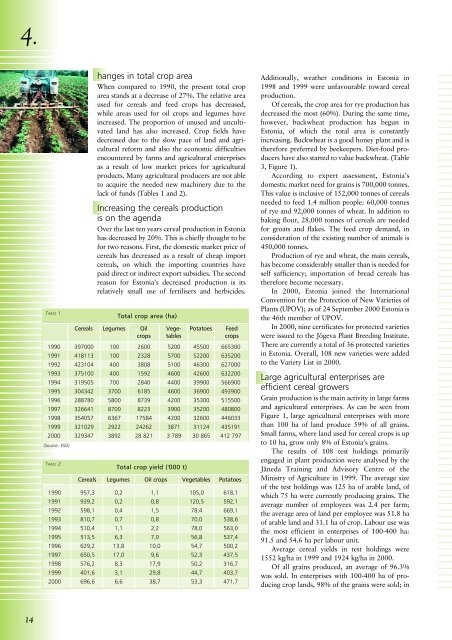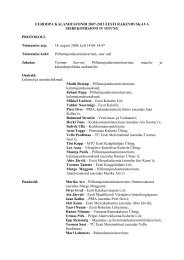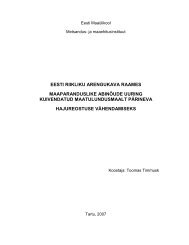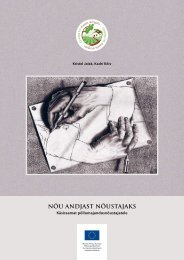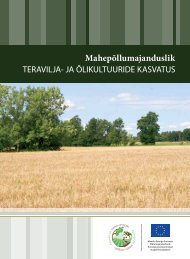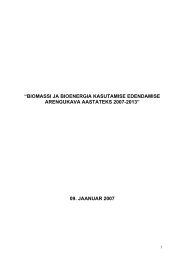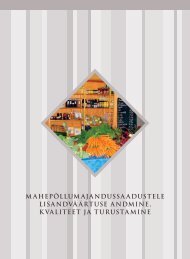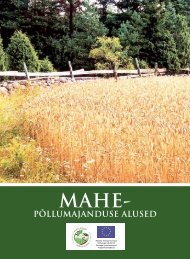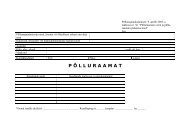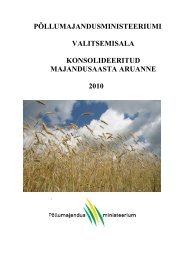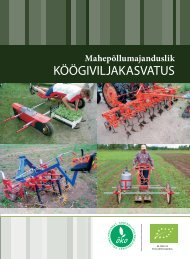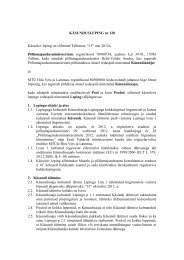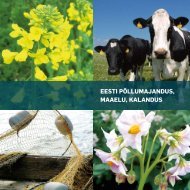estonian agriculture, rural economy and food industry
estonian agriculture, rural economy and food industry
estonian agriculture, rural economy and food industry
Create successful ePaper yourself
Turn your PDF publications into a flip-book with our unique Google optimized e-Paper software.
4.<br />
TABLE 1.<br />
1990<br />
1991<br />
1992<br />
1993<br />
1994<br />
1995<br />
1996<br />
1997<br />
1998<br />
1999<br />
2000<br />
(Source: ESO)<br />
TABLE 2.<br />
1990<br />
1991<br />
1992<br />
1993<br />
1994<br />
1995<br />
1996<br />
1997<br />
1998<br />
1999<br />
2000<br />
Cereals<br />
397000<br />
418113<br />
423104<br />
375100<br />
319505<br />
304342<br />
288780<br />
326641<br />
354057<br />
321029<br />
329347<br />
Cereals<br />
957,3<br />
939,2<br />
598,1<br />
810,7<br />
510,4<br />
513,5<br />
629,2<br />
650,5<br />
576,2<br />
401,6<br />
696,6<br />
hanges in total crop area<br />
When compared to 1990, the present total crop<br />
area st<strong>and</strong>s at a decrease of 27%. The relative area<br />
used for cereals <strong>and</strong> feed crops has decreased,<br />
while areas used for oil crops <strong>and</strong> legumes have<br />
increased. The proportion of unused <strong>and</strong> uncultivated<br />
l<strong>and</strong> has also increased. Crop fields have<br />
decreased due to the slow pace of l<strong>and</strong> <strong>and</strong> agricultural<br />
reform <strong>and</strong> also the economic difficulties<br />
encountered by farms <strong>and</strong> agricultural enterprises<br />
as a result of low market prices for agricultural<br />
products. Many agricultural producers are not able<br />
to acquire the needed new machinery due to the<br />
lack of funds (Tables 1 <strong>and</strong> 2).<br />
Increasing the cereals production<br />
is on the agenda<br />
Over the last ten years cereal production in Estonia<br />
has decreased by 20%. This is chiefly thought to be<br />
for two reasons. First, the domestic market price of<br />
cereals has decreased as a result of cheap import<br />
cereals, on which the importing countries have<br />
paid direct or indirect export subsidies. The second<br />
reason for Estonia’s decreased production is its<br />
relatively small use of fertilisers <strong>and</strong> herbicides.<br />
Legumes<br />
100<br />
100<br />
400<br />
400<br />
700<br />
3700<br />
5800<br />
8700<br />
6367<br />
2922<br />
3892<br />
Total crop area (ha)<br />
Oil<br />
crops<br />
2600<br />
2328<br />
3808<br />
1592<br />
2840<br />
6185<br />
8739<br />
8223<br />
17584<br />
24262<br />
28 821<br />
Vegetables<br />
5200<br />
5700<br />
5100<br />
4600<br />
4400<br />
4600<br />
4200<br />
3900<br />
4200<br />
3871<br />
3 789<br />
Total crop yield ('000 t)<br />
Legumes<br />
0,2<br />
0,2<br />
0,4<br />
0,7<br />
1,1<br />
6,3<br />
13,8<br />
17,0<br />
8,3<br />
3,1<br />
6,6<br />
Oil crops<br />
1,1<br />
0,8<br />
1,5<br />
0,8<br />
2,2<br />
7,0<br />
10,0<br />
9,6<br />
17,9<br />
29,8<br />
38,7<br />
Potatoes<br />
45500<br />
52200<br />
46300<br />
42600<br />
39900<br />
36900<br />
35300<br />
35200<br />
32600<br />
31124<br />
30 865<br />
Vegetables<br />
105,0<br />
120,5<br />
78,4<br />
70,0<br />
78,0<br />
56,8<br />
54,7<br />
52,3<br />
50,2<br />
44,7<br />
53,3<br />
Feed<br />
crops<br />
665300<br />
635200<br />
627000<br />
632200<br />
566900<br />
493900<br />
515500<br />
480800<br />
446033<br />
435191<br />
412 797<br />
Potatoes<br />
618,1<br />
592,1<br />
669,1<br />
538,6<br />
563,0<br />
537,4<br />
500,2<br />
437,5<br />
316,7<br />
403,7<br />
471,7<br />
Additionally, weather conditions in Estonia in<br />
1998 <strong>and</strong> 1999 were unfavourable toward cereal<br />
production.<br />
Of cereals, the crop area for rye production has<br />
decreased the most (60%). During the same time,<br />
however, buckwheat production has begun in<br />
Estonia, of which the total area is constantly<br />
increasing. Buckwheat is a good honey plant <strong>and</strong> is<br />
therefore preferred by beekeepers. Diet-<strong>food</strong> producers<br />
have also started to value buckwheat. (Table<br />
3, Figure 1).<br />
According to expert assessment, Estonia’s<br />
domestic market need for grains is 700,000 tonnes.<br />
This value is inclusive of 152,000 tonnes of cereals<br />
needed to feed 1.4 million people: 60,000 tonnes<br />
of rye <strong>and</strong> 92,000 tonnes of wheat. In addition to<br />
baking flour, 28,000 tonnes of cereals are needed<br />
for groats <strong>and</strong> flakes. The feed crop dem<strong>and</strong>, in<br />
consideration of the existing number of animals is<br />
450,000 tonnes.<br />
Production of rye <strong>and</strong> wheat, the main cereals,<br />
has become considerably smaller than is needed for<br />
self sufficiency; importation of bread cereals has<br />
therefore become necessary.<br />
In 2000, Estonia joined the International<br />
Convention for the Protection of New Varieties of<br />
Plants (UPOV); as of 24 September 2000 Estonia is<br />
the 46th member of UPOV.<br />
In 2000, nine certificates for protected varieties<br />
were issued to the Jõgeva Plant Breeding Institute.<br />
There are currently a total of 36 protected varieties<br />
in Estonia. Overall, 108 new varieties were added<br />
to the Variety List in 2000.<br />
Large agricultural enterprises are<br />
efficient cereal growers<br />
Grain production is the main activity in large farms<br />
<strong>and</strong> agricultural enterprises. As can be seen from<br />
Figure 1, large agricultural enterprises with more<br />
than 100 ha of l<strong>and</strong> produce 59% of all grains.<br />
Small farms, where l<strong>and</strong> used for cereal crops is up<br />
to 10 ha, grow only 8% of Estonia’s grains.<br />
The results of 108 test holdings primarily<br />
engaged in plant production were analysed by the<br />
Jäneda Training <strong>and</strong> Advisory Centre of the<br />
Ministry of Agriculture in 1999. The average size<br />
of the test holdings was 125 ha of arable l<strong>and</strong>, of<br />
which 75 ha were currently producing grains. The<br />
average number of employees was 2.4 per farm;<br />
the average area of l<strong>and</strong> per employee was 51.8 ha<br />
of arable l<strong>and</strong> <strong>and</strong> 31.1 ha of crop. Labour use was<br />
the most efficient in enterprises of 100-400 ha:<br />
91.5 <strong>and</strong> 54.6 ha per labour unit.<br />
Average cereal yields in test holdings were<br />
1552 kg/ha in 1999 <strong>and</strong> 1924 kg/ha in 2000.<br />
Of all grains produced, an average of 96.3%<br />
was sold. In enterprises with 100-400 ha of producing<br />
crop l<strong>and</strong>s, 98% of the grains were sold; in<br />
14


